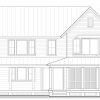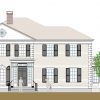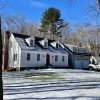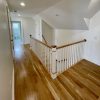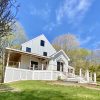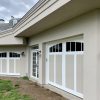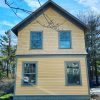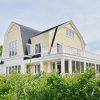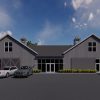On Facebook, we briefly touched on our recent project of rebuilding the “blades” of the Essex Windmill after Hurricane Sandy decided to have her way with the local Connecticut River landmark. Here in this entry, we’d like to share a little more information about the process and give some more depth to the project; because it’s certainly not one of your everyday jobs.
If you haven’t read our earlier entry from 2009 about the history of the windmill, the brief synopsis is that it was self designed and built by Sal Sapia about 40 years ago. The building is actually built to function as a guest house, complete with a kitchen, living room, bathrooms, guest bedrooms, and a bunk room. It’s a tapering octagon in essence, with (4) 20′ blades, pitched and curved to rotate with the slightest breeze.
In fact, this was actually the fourth time the windmill’s blades have been rebuilt. Renditions of redwood, fiberglass, and fir were all experimented with at one point or another to try and get the rotation to operate at optimal performance. The final version of “fir and spruce” proved to be the winner dictated how we’d rebuild them this winter in 2013.
We were actually really excited and honored to have been chosen to complete the project. The windmill property, in general, was recently sold and because of the new ownership, we weren’t sure if we’d get the job. However we were in fact hired and for good reason since the original design/builder was back on the job.
The greatest fact you’ll find in this entire entry is this… the “shaft”, which the blades turn on, is in fact an old tug boat propeller. Back in the 1970’s, the original owner who commissioned the job, was the owner of a boat yard and had the genius idea to utilize something so simple and powerful.
The shaft is approximately 18′ long and reaches just past center of the building. On the outside, it’s attached to a “hub” with four points of attachment for the blades to be bolted into.
The blade beams are made of 20′ long 4×6 structural grade doug fir. Each blade then has a configuration of 2″ – 3″ cross members that make up the body of the blade. All the cross members, horizontal and vertical, were milled down from a custom order of Sitka Spruce from a specialty wood supplier. After days of table saw work and planing, the final result is shown in some of the photos in the gallery, an approximate 56 pieces altogether. We then combined this with 40 different “pitch blocks” set in a specific pattern on the beams to twist the blades into an aerodynamic shape to catch the wind.
Each piece, cross member, pitch block, and beam were then bench primed with an exterior oil based primer and set to dry before assembly. Assembly is pretty straight forward once at this point, just time consuming.
One of the crucial parts of the whole finished product is the stainless steel cable connecting one blade to another. Without it, wind can create too much torque on one particular blade and cause it to break, which is our theory on what happened during Hurricane Sandy. For this go around, we hired a local metal fabricator to make custom stainless steel plates with a swivel connection, which got through bolted through the end of each beam.
Decorative 12 volt marine lighting by Perko was installed at the tip of each beam. Marine grade wiring with stainless steel clips was mounted up the 20′ run where it was tied together and brought into the building along the rotating shaft.
After finished assembly, hardware, and wiring, each blade was painted with a high grade exterior paint inside a heated space and set to dry for 24 hours.
In the end, the most glorious aspect was the actual installation. You’ll see some of the photos in the gallery demonstrate how simple but also how large in scale the project was.
At the end of the fourth day of installation, we all just sat back and watched the blades go around and around… we probably could have stayed all afternoon…
[thumbnails width=”125″ height=”125″]


